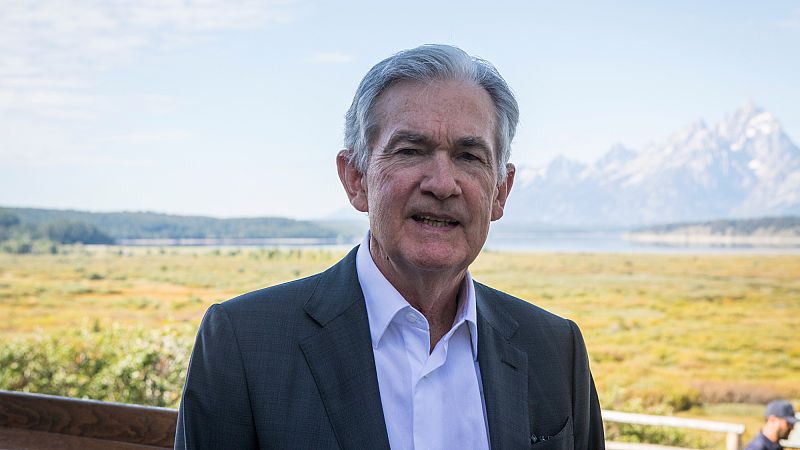
Federal Reserve Chair Jerome Powell is set to take the stage at Jackson Hole later on Friday, and markets are on edge.
The annual central bankers’ symposium, nestled in the Wyoming mountains, has a history of policy-shaping speeches — and this year’s theme, "Labour Markets in Transition", couldn’t feel more apt.
The Fed is walking a tightrope. Inflation remains above the 2% target, yet the jobs market is showing signs of fatigue. Markets speculate the central bank could soon resume cutting interest rates, possibly as soon as September. Fed funds futures suggest around an 80% chance of a 25-basis-point cut.
But what Powell signals in Jackson Hole might complicate that narrative.
Powell speaks at Jackson Hole: What economists expect
This year’s symposium comes on the heels of the most contentious Federal Open Market Committee (FOMC) meeting since 1993. Two Fed governors, Michelle Bowman and Christopher Waller, broke ranks in July to vote for a rate cut, an unusually visible split in the Fed’s ranks.
Markets now want clarity. But they may not get it.
“We do not expect a clear rate signal at Jackson Hole, but rather a clear message of data dependence,” said Rogier Quaedvlieg, senior US economist at ABN Amro.
Powell may highlight labour market imbalances, particularly the falling breakeven rate of non-farm payrolls, and express concern over tariff-induced inflation pressures.
Powell may also use the opportunity to unveil results of the Fed’s five-year framework review.
According to Quaedvlieg, he will likely move away from the flexible average inflation targeting (FAIT) regime introduced in 2020, which could see the Fed reaffirm its commitment to a symmetric 2% target, ditching ambiguity around past inflation overshoots.
Aditya Bhave, economist at Bank of America, believes Powell wants to dial down market expectations.
“He could say that the policy stance remains appropriate given the data at hand. This phrasing would allow him to retain the optionality of cutting if the August jobs report is very weak,” Bhave said.
Conversely, if Powell wants to tee up a cut, he might shift the balance of risks towards the labour market, focusing on weakening payrolls without balancing it with supply-side considerations. That would send a signal to the markets that a rate cut is on the cards.
Ultimately, Powell will likely reflect a broad consensus within the FOMC, which appears willing to back either decision depending on the data.
Alejandro Cuadrado, FX strategist at BBVA, also doesn’t see Powell spelling out a timeline for cuts. With early signs of stagflation creeping in, he argues, the Fed is caught between softening labour markets and stubborn inflation.
“Powell will continue to embrace the beloved Fed optionality,” Cuadrado said.
Cuadrado outlines three main areas to watch. On the labour market, Powell may struggle to define clear thresholds as the data grows murkier.
Inflation remains sticky, with tariffs threatening to push prices higher.
And on policy, a quiet shift away from average inflation targeting could mark a return to a stricter 2% goal.
Political tensions remain elevated and Fed independence is at stake
“The Fed Chair is on the back foot,” said James Knightley, economist at ING.
Just weeks ago, he insisted the labour market wasn’t weakening, only for payrolls data to then be revised sharply downwards.
Powell might stick to his line that unemployment rates are a better gauge than payrolls right now.
But, as Knightley puts it, “If there really were labour shortages, we’d be seeing stronger wage growth. We’re not.”
And then there’s the political noise. Treasury Secretary Scott Bessent reportedly favours a bold 50 basis point cut.
Trump’s temporary Fed board pick, Stephen Miran, might push for even more if confirmed in time. Whether figures like Bowman or Waller would follow suit remains to be seen.
Still, it’s not just about September. The more divisive question is what happens after.
What to expect from Powell’s tone
This is less about what Powell says, and more about what he leaves unsaid. He’s unlikely to pre-commit to a move, nor explicitly shut the door on one.
With another jobs report and inflation print still to come before September, the Fed’s preferred course is to preserve optionality.
The real question is whether markets are willing to let them.
Financial conditions have already loosened on expectations of a cut. If Powell wants to push back, he’ll have to be firmer than usual. But if he’s comfortable with market pricing, even vague nods to labour market risks could be enough to reinforce the dovish shift.







